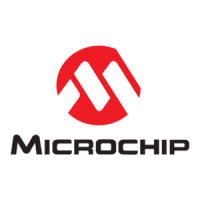On the PIC32MX/PIC32MM/PIC32MZ/PIC32MK family never use the REFCLK as a source clock for any
asynchronous peripheral (i.e., UAR
T, CAN, ADC, and so on). The REFCLK produces a pseudo fractional
clock frequency by cycle stealing to produce an average frequency, so over a given unit of time the
number of clock pulses are not consistent. This means that the CAN bit times cannot be guaranteed.
11.7.2 CAN FD Hardware Requirements
• There are only two 120 Ohm bus termination resistors installed or configured in a CAN network at the two
physical end points of the CAN network between CAN_H and CAN_L.
–
This can be checked easily by powering down all CAN devices and measuring the resistance in between
the "CAN High" and "CAN Low" wires. The measured resistance must be approximately 60 Ohm (i.e.,
RPARALLEL = ((120 *120 )/ (120 + 120)) = 60 Ohm). Any value lower than 60 Ohm indicates that there are
probably more than two 120 Ohm bus termination resistors present and this must be resolved.
– The 120 Ohm terminating resistor must be between CAN high and CAN low for it to work correctly.
– A value larger than 60 Ohm typically indicates that there is at least one bus termination resistor missing, or
the bus terminators have the wrong resistance value.
– The proper placement of the two bus terminators of 120 Ohm at both end points of the network has to be
checked visually.
– The CAN GND in the network must have exactly one point connected to earth potential.
– When using double shielded cables, the outer shield needs to be connected to the earth potential at one
point. There must not be more than one connection to the chassis/earth ground in the network.
• Two types of CAN cables are Unterminated and self-terminated. Terminated cables already have the 120-
termination built into the cable assembly. Ensure that terminated cables are not mixed with CAN terminated
circuit nodes. When connecting multiple CAN devices that already have termination, non-terminated cables are
required.
Figure 11-13. Typical CAN Network
Serial Data Corruption Errors
© 2022 Microchip T
echnology Inc.
and its subsidiaries
Manual
DS70005439B-page 49

